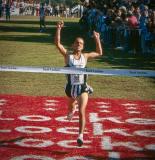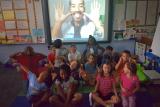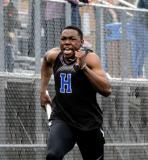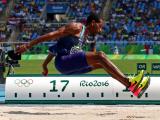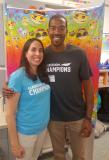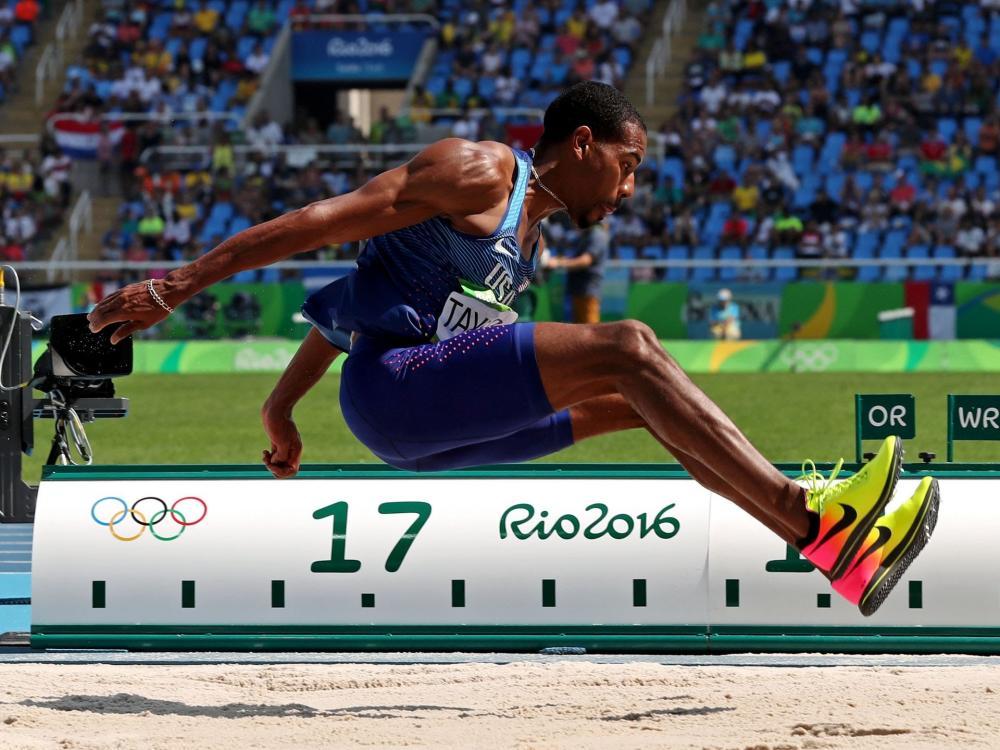Folders |
Christian Taylor Has Entered The Chat: Olympic Triple Jump Champion Finds Meaning Through MentoringPublished by
Christian Taylor Has Entered The Chat 'Superhero' Track Athlete Engages Kids Through Classroom Champions A DyeStat story by Dave Devine _____________ It’s nearly Halloween. Not the fraught, precarious Halloween of 2020, when pandemic concerns render even the innocent joy of trick-or-treating a tenuous prospect, but the Halloween of a year ago — October 2019 — before anyone had heard of COVID-19 or imagined the paralyzing affect it would have on everyday American lives. Halloween a year ago, and the sixth-grade students at Glenn L. Downs Elementary School in Phoenix, Arizona, have been given a challenge by their teacher, Ella Maya. She’s distributed a worksheet asking them to design a Halloween costume for Christian Taylor, the virtual mentor they’ve been paired with through a program called Classroom Champions. A guy they’ve primarily gotten to know through YouTube videos and virtual chats. “What Should Christian be for Halloween?” Miss Maya’s worksheet reads, above a Xeroxed photograph of Taylor’s head connected to a blank, outlined body. Draw a costume for Christian. Explain why you chose it. When the handouts are submitted, more than one middle schooler has depicted the tall, lean triple jumper as Jack Skellington, the protagonist of the 1993 film, The Nightmare Before Christmas. Because: He is tall and Jack Skellington is tall. Then there is Christian as a frog. An apple. A police officer and a werewolf. Frankenstein’s monster. A Samurai warrior. Eventually, however, a trend emerges. Here is Christian as Superman, complete with six-pack abs and a flowing cape. Because: When he jumps, he flies. And then, The Flash. Two Batman’s in quick succession. Another Flash. Six or seven renderings of Taylor as Frozone, the lanky hero from Pixar’s The Incredibles. The students comment on his speed. His strength. The flying. Given the choice of any Halloween costume for their mentor, the students in Miss Maya’s class overwhelmingly depict Taylor as a superhero.
He was going to be an astronomer. That’s what Christian Taylor figured. Or maybe not — it was hard to say. He was in fourth grade, and everything sounds good when you’re in fourth grade. But his career path would definitely have something to do with outer space: stars and launching and soaring. Those things captured his imagination. Or maybe dinosaurs. But for sure — science. Because of Mrs. Patrick. She was a beloved fourth-grade teacher at Robert J. Burch Elementary in Tyrone, Georgia, regularly convening a science club in her classroom for students willing to hang around after school. Taylor was a frequent attendee. The group might discuss space exploration, watch nature videos or conduct experiments intended to hook young minds on scientific thinking. Each afternoon was an adventure. But the thing that stayed with Taylor, well past his elementary years, was a lesson that transcended science. “She always challenged us to think beyond,” Taylor says. “To push the limits. She’d say, ‘Why do you stop there, Christian? You have to keep going.’” The fact that Taylor was even in that classroom after school to absorb those lessons owed, in large part, to lessons he’d received from his parents, years earlier. Originally from Barbados, Ian and Stephanie Taylor raised Christian and his younger sister, Kaitlyn, with a value system that included close connection to their Bajan roots and clear expectations around responsibility and commitment. “It’s been instilled in me from the very beginning,” Taylor says. The high standards began in early childhood with Christian’s role as a big brother to Kaitlyn, continued through the science club days in elementary school, and fully emerged as Taylor took on leadership roles at Our Lady of Victory Catholic Middle School. A natural athlete, he tried to help the small Catholic school live up to its name by joining as many sports as possible: football, soccer, basketball — “I was even running cross country, believe it or not” – and then filled in the gaps with extracurriculars like the 4-H Club, for which he raised a pig. “We were really country,” he says, laughing. Even as leadership roles came naturally for Christian, Ian and Stephanie pushed their son to expand his understanding of what those roles required. Step up to lead, yes, but find someone to bring with you. The message to Christian was clear. Simple leadership wasn’t enough, he was expected to lift others along the way. That sense of responsibility — and the early lessons that honed it — served Taylor well through high school at Sandy Creek High, three years at the University of Florida, and a professional track and field career that has seen him win two Olympic triple jump gold medals and four world championships. And always in the background, the whispers of his early educators. His parents’ persistent encouragement; Mrs. Patrick’s gentle chiding. “Even now,” he says, “I hear those things in the back of my head, especially Mrs. Patrick: Why stop there, Christian? Why stop there?”
When Taylor ascended the podium at the 2012 London Olympic Games, it should have been a crowning moment in his young life. Grinning in his gray Team USA windbreaker, he blinked into the stadium lights and held his triple jump gold medal aloft in disbelief. His Florida teammate and good friend, Will Claye, stood alongside him as the silver medalist. All the pieces were there. A childhood dream, realized far earlier than anyone might have expected. But if Taylor anticipated elation in the wake of that success, if he imagined feeling sated by the achievement, he instead found himself, in the weeks after London, wrestling with unexpected emotions. Restlessness. Disappointment. A gnawing sense of loneliness. The distinct feeling that something was missing. It had been, until then, a meteoric rise for the once-aspiring astronomer. By the end of his junior year at the University of Florida, Taylor had won multiple NCAA indoor and outdoor triple jump titles. When he took the 2011 USATF Outdoor Championship gold that summer to qualify for the World Championships in Daegu, South Korea, he decided to leave his studies at Florida and train full-time as a professional track athlete under coach Rana Reider. The focus paid off, with a triumph in Daegu, victory the next summer at the 2012 U.S. Olympic Trials, and his place atop the medal podium in London. It was an astonishing string of success for a leaper not yet 23 years old. And yet — “It all happened so quickly in my career,” Taylor says. “I was extremely blessed, extremely fortunate, but at the same time I found myself feeling incomplete.” Back home at his Florida training grounds he grappled with those confusing emotions. Wondered how he might contribute something else to society. “I had this yearning for more,” he says. When he shared that desire with his marketing agent, and asked him to research some possibilities, the answer turned out to be an opportunity Taylor called a “two-part win.” Join a non-profit started by a fellow Florida Gator and begin to do meaningful work with young people. Steve Mesler, a national high school champion in the indoor pentathlon, had battled through an injury-riddled career as a Gator decathlete in the late 1990’s before turning to winter sports, and the bobsled, in the early 2000’s. At the 2010 Winter Olympics he was a pusher for the four-man team that won the United States’ first gold medal in the event in 62 years. Like Taylor, he had stood atop an Olympic podium. And also, like Taylor, he knew that feeling of yearning for something more. Like many elite athletes, Mesler had been invited over the years to give classroom talks or appear at school assemblies to share the “lessons he’d learned from the sport.” The interactions always felt cursory to him, and left him eventually wondering if there wasn’t a way to have a bigger impact than these drop-in events seemed to deliver. With his sister, Dr. Leigh Parise, a teacher and educational researcher, he founded the Classroom Champions in 2009 to offer consistent, recurring mentorship from talented Olympians and Paralympians to classrooms throughout the United States and Canada. “We didn’t want to create a program that was a mile wide and an inch deep,” Mesler says. “We wanted something an inch wide and a mile deep.” In 2013, when Taylor first reached out to Mesler, that vision spoke clearly to the connections the triple jumper hoped to forge with young people off the track. “Assemblies are great for maybe that week,” Taylor says, “and then the buzz is gone. But Steve said, ‘No, we want to build relationships with these kids and teachers.’” Paired with his first slate of teachers in 2014, Taylor has mentored multiple classrooms — anywhere from five to 10, depending on the need — every year since. Each month he sends video messages, responds to student work and engages his classrooms over social media using a variety of hashtags and call-outs. Twice a year, he conducts a live video chat with each partner classroom. “You almost feel like a teacher,” Taylor says. Which isn’t far from the truth, according to experienced Classroom Champion partners like Maya, the sixth-grade teacher from Phoenix. “It’s really about having another trusted and respected adult in the room, even if it’s virtually.” Asked about the qualities that make Taylor an effective mentor, Maya mentions a combination of authenticity and vulnerability that her middle schoolers found immediately relatable. “Christian just has this way of being which — you can tell that it’s completely genuine. Sixth grade is not an easy age group to relate to, and Christian had a way of presenting his challenges and his successes in a way that wasn’t condescending. He was talking to them, and not at them.” Mesler mentions that authenticity as well, along with Taylor’s attentive listening and near-constant smile — “small things,” he says — but elements that students find reassuring, regardless of age. “It shows them they have value,” Mesler says, “that Christian truly sees and hears them.”
Taylor was fielding dozens of questions, all at once. How tall are you? Did you bring your medal? Can I hold your medal? It was like a media gaggle in the mixed zone at a Diamond League meet, only all of the reporters were children. A dizzying array of questions, floating from somewhere near waist-level: Can you touch the ceiling? Can you make it from the back of the classroom to the front with only one step? Can you jump over my desk? Can you jump over my friend? And Taylor, on a surprise visit to a first-grade classroom he’d been mentoring in Orlando, Florida, addressed each inquiry with the same gregarious demeanor he brings to mixed zone interactions. Beaming smile, patient bearing. But one question, in particular, stood out for its boldness. “You wanna race?” Taylor still laughs about the brazenness of that challenge. “I was like, ‘You are literally two feet tall. You have no chance.’ But that kid — he did not back down.” The teacher of those first graders, another Florida alum named Martina McQuire, also remembers the gauntlet being thrown. “We were outside at field day,” she says. “It was a boy named Ian, he was super competitive.” Although most of Taylor’s mentoring occurs virtually due to travel and competition schedules, he manages to conduct a handful of in-person visits each year — mostly to partner schools in Florida when he’s in-state for training. McQuire, who started with Classroom Champions in 2013, had been paired with Taylor for several years by the time he dropped into her school’s field day one afternoon. She lights up describing her students’ reactions. “It’s all wide-eyed faces and hugs,” she says, “and a hundred questions.” For most of the students, “It’s like they’re finally meeting their friend — Oh, my friend Christian is here.” It’s a bond she works hard to cultivate. During morning meetings (in pre-COVID days) the students sit in a circle on the carpet and greet everyone by name, including Taylor, even though he’s not physically present. Good morning, Christian! If there are conflicts in the classroom, she raises the question: What would Christian do? Big accomplishments: Christian would be so proud of you all. “He’s another member of our classroom family,” McQuire says. But if Taylor offers something tangible as a mentor with relatable, real-world experience in social and emotional skills like resilience, goal-setting and growth mindset, he firmly believes the students offer at least as much in return. Which leads him back to those weeks after the 2012 Games, his emptiness in the wake of success. “After London, I really wondered if that was it. I had this sense of loneliness…like, when you get to the mountaintop and it’s a cloudy day? You think, wow — I came so far, I worked so hard, and that’s it?” What he needed, he realized was companions for the journey. Get there yourself, but bring others along. He craved connection to something larger than his own dreams, a community outside the daily toil of professional athletics. Something like…a throng of students invested in his efforts. His own personal accountability army. Perhaps not surprisingly, Classroom Champions has delivered that in spades. “It really is like this army behind me now,” he says. When Taylor arrived in Rio de Janeiro, Brazil, for the 2016 Olympic Games, he was buoyed by videos from school children all around the country. Carried drawings from students who’d already depicted him winning gold. And 11 days into those Games, he did exactly that, spanning 58 feet, 7.25 inches (17.86m) to again claim the top spot on the Olympic podium. “In a real sense now,” he says, “I’m no longer competing for Christian Taylor. I’m competing for my Champions.” But if Taylor carries his students along for the triumphs, he also views Classroom Champions as a platform for transparency, letting teachers and students know that some days he falls short. Which is exactly what Mesler was hoping when he founded the program. “We wanted to show kids that sometimes it sucks,” Mesler says. “Sometimes it’s hard. Sometimes you get hurt. When you just watch the Olympics you only see the glory. Or you see the failures, but you don’t really get the process.” There’s one setback, in particular, that Taylor references frequently with students. In the build-up to the 2013 World Championships, a nagging pain in his left knee — the take-off leg for his signature event — grew increasingly worse until Taylor could no longer effectively train. It was eventually diagnosed as patella tendonitis, and became so debilitating that Taylor and his coach were left with an excruciating choice: switch take-off legs and see if the career left-foot jumper could completely rebuild his mechanics to leap off the opposite leg, or walk away from the event. They decided to rebuild his jump. “You either hang your spikes up,” Taylor says, “or you go for it. And I thought, at the end of the day, if I go for it and fail, I’m at the exact same spot as I would have been if I just quit.” The gambit paid off, with a reinvigorated Taylor matching or surpassing everything he’d accomplished prior to the astonishingly difficult switch: three more world titles; another Olympic gold; and the second-longest jump in history, trailing only Jonathan Edwards’ legendary 60-0.25 (18.29m) world record by 8 centimeters. At his lowest points, when he had to relearn how to jump from scratch, or when that rebuilt jump still wasn’t yielding results, he often heard, whispering forward from fourth grade, Mrs. Patrick’s words: Why stop there, Christian? Why stop there? “If I fall short,” Taylor says, “I tell the kids I’m not defeated. I pick myself up and ask what I can do differently in the next year. And this is the approach they need to take into the classroom.” Confidence tempered with humility, which circles him back to that student at field day. Ian and his bold question — Wanna race? And McQuire, watching it unfold, attempting to discourage any challenges to the visiting Olympian. “I kept saying, ‘No you guys, you have to be careful with Christian. He can’t race you.’ I’m thinking, he’s a professional athlete and we can’t be the ones who get him hurt.” But Taylor had other ideas. “I said, ‘OK, let’s go. Let’s race.’” When the mismatched competitors reached the improvised starting line, Taylor got his second surprise. Every student in the class was elbowing to race. “I just loved how contagious that was,” he says. “At such a young age, you don’t have that fear.” Someone shouted Go! and Taylor blasted from the line with over a dozen first graders hot on his heels. “Those first two steps,” he admits, “I actually went out hard, just to kind of shock them.” Eventually, he allowed the pack to overtake him. “Literally every kid beat me.” His giggling army, flying past. And watching anxiously from the sidelines, praying for no twisted ankles or sprained knees: Mrs. McQuire, shaking her head at the good fortune to be paired with Taylor for another year. “When I think about the impact he’s had on my classes alone,” she says, “all those kids, like six years’ worth of children — that’s just one teacher. And he’s had multiple teachers every year. His impact goes way beyond his sport.”
It can be tempting, of course, to think of the superhero as simply powerful. A mighty being, imbued with invincibility. Easy to imagine the reason that all those students in Miss Maya’s sixth grade class sketched Taylor in superhero costumes was because of a certain potency they perceived. Speed. Strength. Flight. But in the end, the superhero mantle wasn’t about those things at all. It was about the humanity the students grasped from connecting with the man, not the champion on the podium. It was about vulnerability and fallibility. Superman leveled by Kryptonite. A broken Batman. The triple jumper with the ruined knee. “Early on,” Mesler says, “we had feedback from teachers that — almost the problem was that the kids saw these people as superheroes.” There was a concern that the students would never be able to relate to the mentors. But Taylor, as Mesler points out, is as good as any mentor in the program at pulling back the curtain to show the obstacles and missteps along the way. “For them to be able to see him, still, as a superhero, but know that he’s vulnerable, and know that he makes mistakes, is actually a really good indicator of what it means to be a superhero.” McQuire has seen those same qualities, an approachability most children never sense from professional athletes. “Here’s this person that’s a famous person,” McQuire says, “but he’s going through the same things, too. And he talks about all of that.” And right now, the thing they’re all going through — we’re all going through, collectively — is a global pandemic that has altered nearly every aspect of daily life. Mesler and his team have had to figure out what it means to be the Classroom Champions when, in many cases, there are no longer classrooms — at least in the traditional sense. Since the program has been largely virtual from the outset, he faced far fewer changes than other leaders of educational non-profits. “We didn’t have to pivot,” he says, “we just had to adjust.” Social and emotional learning, he points out, has never been more important; he’s hopeful that more classrooms and districts will adopt Classroom Champions’ SEL curriculum. And he’s looking to spread the word with about a million dollars in grants and scholarships the program plans to distribute to needy school districts this academic year. The approach, Taylor says, has been to stick with what works. Remain true to the program’s existing strengths. “We have this unique feature of bringing Olympians to the classroom — that’s something that no other program is doing. In a time of people trying to restructure and re-program, we can say, ‘We’re already here.’” If he sounds like someone invested in the success of the program, that’s because he is. Seven years in, he’s one of the longest-serving mentors. This year, he’ll spend virtual time in seven different schools throughout the United States. Last March, he joined Classroom Champions’ Board of Directors, the first currently competing athlete to serve on the board in the program’s history. In the midst of all of that, he continues to train for a delayed Olympics. He’s advancing the cause of athletes’ rights through The Athletics Association he helped launch in 2019. He recently returned, at age 29, to the University of Florida and completed his degree. If he’s a superhero, he says, it’s as much about vulnerability as power. As much about opportunities and possibilities as accomplishments and laurels. There’s still plenty he hopes to do. The world record is out there, tantalizingly close. There are still more students to mentor, virtually for now, eventually in-person. More first graders to race. He wants to be the kind of role model who impacts young people in positive ways. He hopes that the wisdom he shares, the words he offers, might resonate and rattle around, years and decades later. Become the sort of gentle, lingering voice that continuously urges students forward: Why stop there, Christian? Why stop there? - More news |


